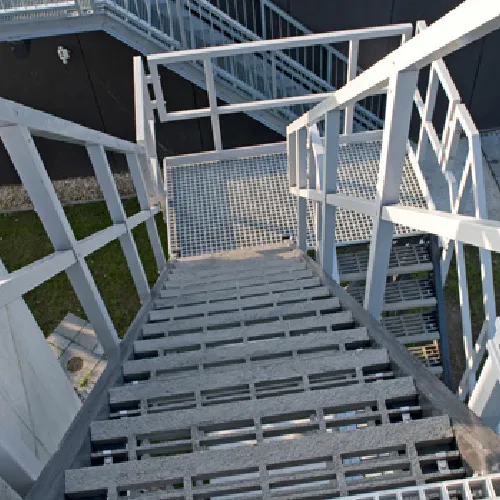loading...
- No. 9, Xingyuan South Street, Dongwaihuan Road, Zaoqiang County, Hengshui, Hebei, China
- admin@zjcomposites.com
- +86 15097380338
- Welcome to visit our website!
Exploring Innovative Applications of FRP Mini Mesh in Modern Architecture and Design Techniques
Exploring the FRP Mini Mesh A Versatile Solution for Modern Applications
In the realm of modern materials, the advent of Fiber Reinforced Polymer (FRP) has revolutionized various industries by providing unique properties that traditional materials cannot match. Within this exciting field, FRP mini mesh stands out as a particularly versatile option, catering to a myriad of applications across construction, infrastructure, and even art. This article delves into the characteristics, benefits, and applications of FRP mini mesh, illustrating its growing significance in contemporary design and engineering.
Understanding FRP Mini Mesh
FRP mini mesh is made from a matrix of polymer resin reinforced with fibers, usually glass, carbon, or aramid. The term “mini mesh” refers to its fine grid-like structure, which allows for enhanced performance in terms of strength and flexibility. This intricate design not only reduces weight compared to solid materials but also maintains high tensile strength. The mesh structure can be tailored to meet specific performance requirements, making it an adaptable choice for various applications.
Key Benefits
1. Corrosion Resistance One of the primary advantages of FRP mini mesh is its resistance to corrosion. Unlike traditional materials such as steel, FRP does not rust or degrade when exposed to harsh environmental conditions. This property prolongs the lifespan of structures, making FRP mini mesh a cost-effective solution in the long run.
2. Lightweight The lightweight nature of FRP mini mesh is a significant advantage, especially in construction and transport. It reduces the overall load on structures and facilitates easier handling and installation, thus saving time and labor costs.
3. High Strength-to-Weight Ratio The strength provided by FRP mini mesh is remarkable. It offers an exceptional strength-to-weight ratio, which makes it an ideal choice for applications that require strong, yet lightweight materials.
4. Design Flexibility The mesh structure allows for creative and innovative designs that can incorporate various aesthetic elements. Designers and architects appreciate the ability to customize the mesh to suit the visual and functional requirements of their projects.
frp mini mesh

5. Fire Resistance FRP materials are inherently non-combustible, providing an extra layer of safety for various applications. This property is especially useful in environments where fire hazards are a concern.
Applications of FRP Mini Mesh
The applications of FRP mini mesh are vast and varied
- Construction In the construction industry, FRP mini mesh is often used to enhance the structural integrity of slabs, panels, and beams. It can be embedded in concrete or used as standalone elements in building systems.
- Infrastructure FRP mini mesh is widely utilized in infrastructure projects such as bridges, walkways, and drainage systems. Its lightweight and corrosion-resistant properties make it an ideal material for components exposed to moisture and chemicals.
- Art and Design Artists and designers are increasingly incorporating FRP mini mesh into their work, leveraging its flexibility and aesthetic potential. From sculptures to functional furniture, the mesh allows for creative expression while meeting structural needs.
- Marine Applications The marine industry benefits significantly from the use of FRP mini mesh, particularly in boat building and offshore structures, where the resistance to corrosion and lightweight nature are crucial.
Conclusion
As industries continue to evolve, the demand for innovative materials like FRP mini mesh will undoubtedly grow. Its combination of lightweight, durability, and versatility provides a compelling alternative to traditional materials, enabling engineers and designers to push the boundaries of what is possible. Whether in construction, infrastructure, or the arts, FRP mini mesh is poised to play a significant role in shaping a more sustainable and aesthetically pleasing future.
-
GRP Structures: The Future of Lightweight, High-Performance EngineeringNewsJun.20,2025
-
FRP Water Tank: High-Performance Storage for Corrosive and Clean Water SystemsNewsJun.20,2025
-
FRP Square Tube: The New Industry Standard for Chemical and Structural ApplicationsNewsJun.20,2025
-
FRP Pultruded Profiles: The Ultimate Choice for Lightweight Structural StrengthNewsJun.20,2025
-
FRP Handrails: The Safer, Smarter, and Stronger Choice for Modern InfrastructureNewsJun.20,2025
-
FRP Grating: The Smart Solution for Durable, Lightweight Industrial FlooringNewsJun.20,2025
-
Why Choose a Galvanized Water Tank for Your Storage NeedsNewsMay.21,2025
